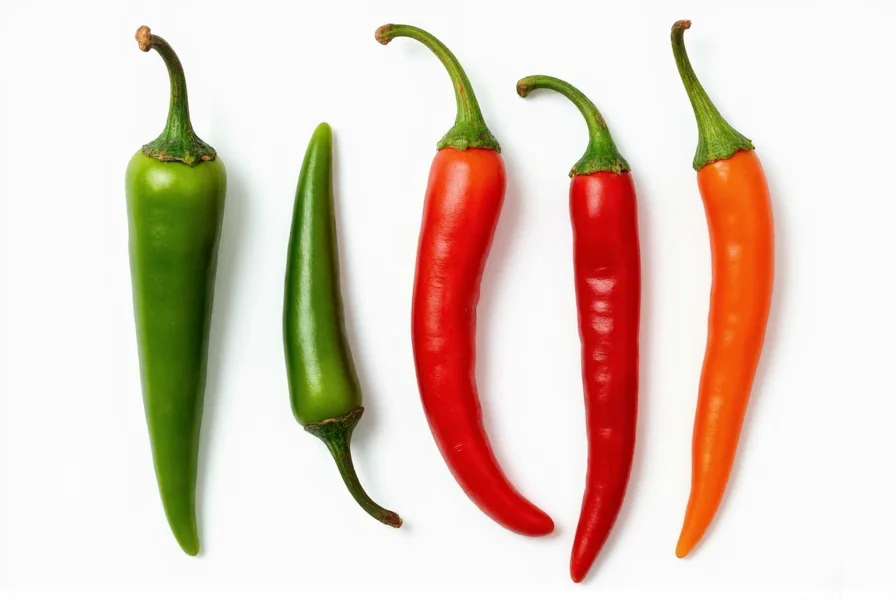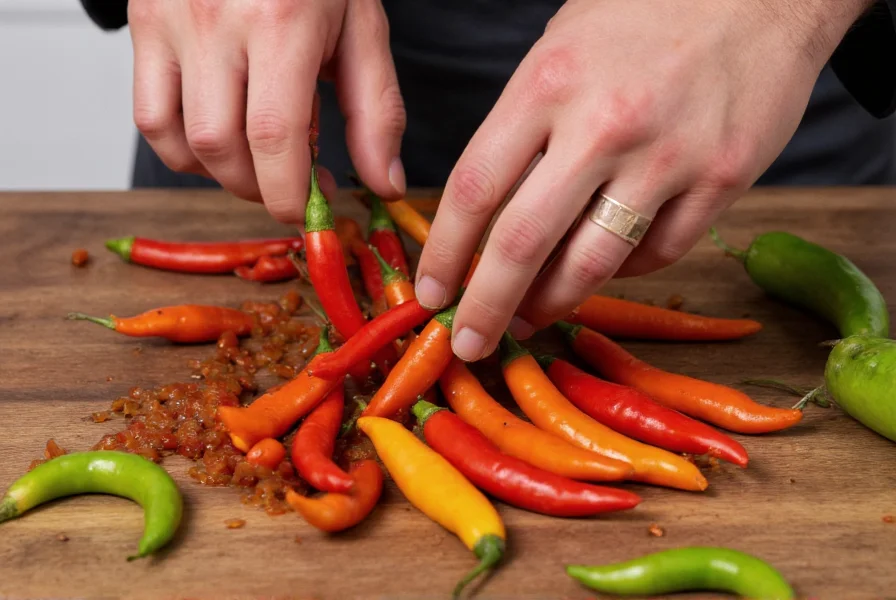When your recipe calls for serrano peppers but you're staring at an empty spice rack, knowing the right substitute can save your dish. Serrano peppers, with their bright green color and distinctive heat, are staples in Mexican and Southwestern cuisine. Understanding what makes them unique helps you choose the perfect replacement.
Understanding Serrano Peppers' Characteristics
Serrano peppers typically measure 10,000-23,000 Scoville Heat Units (SHU), placing them significantly hotter than jalapeños (2,500-8,000 SHU) but milder than habaneros (100,000-350,000 SHU). They offer a grassy, slightly floral flavor with crisp texture that holds up well in both raw and cooked applications. When seeking a serrano pepper replacement in recipes, consider both heat level and flavor profile to maintain your dish's integrity.
Top Serrano Pepper Substitutes Compared
| Substitute | Heat Level (SHU) | Flavor Profile | Best Used In | Substitution Ratio |
|---|---|---|---|---|
| Jalapeño | 2,500-8,000 | Grassy, vegetal, less complex | Salsas, nacho cheese, stuffed peppers | 2:1 (use twice as much) |
| Cayenne | 30,000-50,000 | Sharp, pungent, less fresh flavor | Cooked dishes, sauces, marinades | 1:2 (use half as much) |
| Thai Bird's Eye Chili | 50,000-100,000 | Intense heat, citrus notes | Asian-inspired dishes, hot sauces | 1:3 (use one-third as much) |
| Guajillo (dried) | 2,500-5,000 | Fruity, berry-like, mild heat | Moles, stews, braises | 1 dried pepper = 2 fresh serranos |
Choosing the Right Substitute for Your Recipe
The ideal serrano pepper substitute depends on your specific cooking needs. For fresh applications like pico de gallo or raw salsas, jalapeños provide the closest texture with less heat. Remove seeds and membranes from jalapeños to better match serrano's heat profile. When preparing cooked dishes like chili verde or enchilada sauce, consider using a combination of jalapeños and a pinch of cayenne powder to replicate both the flavor and heat.
For those seeking a serrano pepper substitute for canning, jalapeños maintain their structure well during the preservation process. If you're making a dish where appearance matters, such as stuffed peppers, jalapeños offer a similar size and shape. When substituting in Mexican recipes specifically, consider using fresh green Thai chilies for the closest heat match, though you'll need to adjust quantities carefully as they can be significantly hotter.
Adjusting Recipes When Substituting Peppers
Understanding how to modify your recipe when using a serrano pepper replacement is crucial for cooking success. When using milder alternatives like jalapeños, you may need to increase quantity but be cautious about altering the dish's moisture content. For hotter substitutes like cayenne, start with half the amount and taste as you cook, remembering that heat intensifies during cooking.
For the best results with any serrano pepper substitute in recipes, always taste-test before finalizing your dish. Add substitute peppers gradually, allowing time for flavors to meld. When substituting dried peppers for fresh serranos, rehydrate them properly by soaking in hot water for 20 minutes before use. This serrano pepper alternative technique works particularly well for complex sauces and stews.

Regional Availability Considerations
Depending on where you live, certain substitutes may be more accessible than others. In North American supermarkets, jalapeños are widely available year-round, making them the most practical serrano pepper substitute for most home cooks. In Asian markets, fresh Thai bird's eye chilies offer a closer heat match. For those in Europe, where serranos are less common, cayenne peppers or even serrano's close relative, the Spanish padrón pepper (when mature and hot), can work as alternatives.
When shopping for a serrano pepper replacement in recipes, check the stem end of peppers—freshness indicators apply to all chili varieties. Look for firm, glossy skin without wrinkles or soft spots regardless of which substitute you choose. Proper storage extends the usability of your substitute peppers; keep them in a paper bag in the refrigerator's vegetable drawer for up to three weeks.
Special Considerations for Dietary Restrictions
For those following specific dietary protocols, understanding serrano pepper alternatives becomes even more important. In low-FODMAP diets, small quantities of jalapeños can substitute for serranos with less digestive impact. When preparing dishes for children or those with low heat tolerance, bell peppers combined with a pinch of cayenne provide flavor without overwhelming heat. For keto-friendly recipes, all pepper substitutes maintain the low-carb profile essential to the diet.

Expert Tips for Perfect Substitutions
Professional chefs recommend these techniques when working with serrano pepper substitutes. For raw applications, remove seeds and membranes from hotter substitutes like cayenne to better match serrano's heat distribution. When making hot sauces, blend milder substitutes with a touch of vinegar to replicate serrano's bright acidity. For the best serrano pepper substitute for salsa, combine jalapeños with a small amount of poblano for depth of flavor without excessive heat.
Remember that cooking transforms pepper heat—dishes containing substitutes will mellow slightly as they sit. Always wear gloves when handling hot pepper substitutes, and never touch your face. If you accidentally make a dish too spicy, dairy products like yogurt or sour cream can help balance the heat without altering flavor significantly.
Frequently Asked Questions
Can I use jalapeño instead of serrano in salsa verde?
Yes, you can substitute jalapeño for serrano in salsa verde, but use approximately twice as many jalapeños since they're milder. For the closest flavor match, remove seeds from 4 jalapeños to replace 2 serranos. The texture will be similar, though the heat level will be more moderate.
What's the best mild substitute for serrano peppers?
The best mild substitute for serrano peppers is jalapeño with seeds and membranes removed. For even milder options, consider using poblano peppers in cooked dishes or bell peppers with a pinch of cayenne powder for minimal heat. These serrano pepper alternatives work well for those sensitive to spice while maintaining recipe integrity.
How do I substitute dried peppers for fresh serranos?
To substitute dried peppers for fresh serranos, use guajillo or árbol peppers. Soak 1 dried pepper in hot water for 20 minutes to replace 2 fresh serranos. Dried peppers provide deeper, fruitier flavors better suited to cooked dishes like moles or stews rather than fresh applications.
Are serrano peppers hotter than jalapeños?
Yes, serrano peppers are significantly hotter than jalapeños. Serranos range from 10,000-23,000 Scoville units while jalapeños measure 2,500-8,000 units. This means serranos can be up to 9 times hotter than jalapeños. When substituting jalapeños for serranos, use approximately twice as many to achieve similar heat levels.










 浙公网安备
33010002000092号
浙公网安备
33010002000092号 浙B2-20120091-4
浙B2-20120091-4